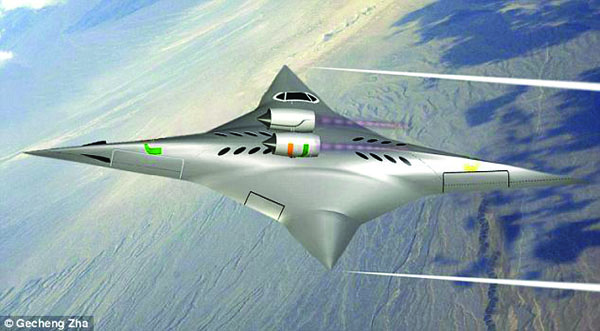
Consider a plane that can fly sideways and enter supersonic mode without a supersonic boom.
Not to be confused with a UFO, the aircraft looks like a four-cornered ninja star plastered with the orange and green U logo.
And it can take you from New York to Los Angeles in two hours flat.
This crazy contraption, called a supersonic bi-directional flying wing nonetheless, is not something out of a childhood Dr. Seuss tale.
The man who came up with this machine is GeCheng Zha, an associate professor in aerospace engineering at UM. He holds a Ph.D. from the University of Montreal.
NASA recently awarded Zha and his team of researchers a $100,000 grant for the supersonic bi-directional flying wing concept, allotting them further exploration.
A sleek aircraft model with four wings, the plane uses its longer wingspan for take-off, while the two shorter wings create less drag once it turns on its side and continues flying into the uppermost parts of space, according to an article published in The Daily Mail.
The grant was awarded by NASA’s Innovative Advanced Concepts division, which promotes noteworthy ideas that can impact future NASA endeavors. The money will allowZha and his team to continue their research on the bi-directional flying wing for an additional year, bringing them one step closer to their goal of breaking the supersonic barrier.
“It’s exciting, and I hope this inspires others,” Zha said.
Zha’s concept for this unique plane design can potentially change the future of air travel by remedying two problems that are inherent to traveling at supersonic speeds.
The first is noise, Zha said. The plane’s speed would not create the thunderclap sound produced by a sonic boom, reported Space.com.
“As you break the sound barrier, it is very noisy. That is one of the reasons supersonic travel was forbidden by land,” Zha said.
The second is that supersonic air travel consumes an enormous amount of fuel.
“This design greatly improves fuel efficiency and minimizes the amount of noise, bringing us closer to supersonic travel,” Zha said.
The supersonic bi-directional flying wing’s 90-degree rotation would not produce an intolerable G-force, or the force due to the acceleration of gravity during free-fall. The flight experience would be milder than that of what airline passengers feel during take-off, according to Space.com.
It may take decades for this concept to become reality, according to an article published in The Daily Mail, but the funds still give the research a giant boost. Zha looks forward to making the once-unimaginable notion a scientific mainstay.
“Long ago we used to think the earth was flat, and that our solar system was at the center of everything,” he said. “Now we know that our solar system is just a piece of it all, and we’ve landed a rover on Mars.”






